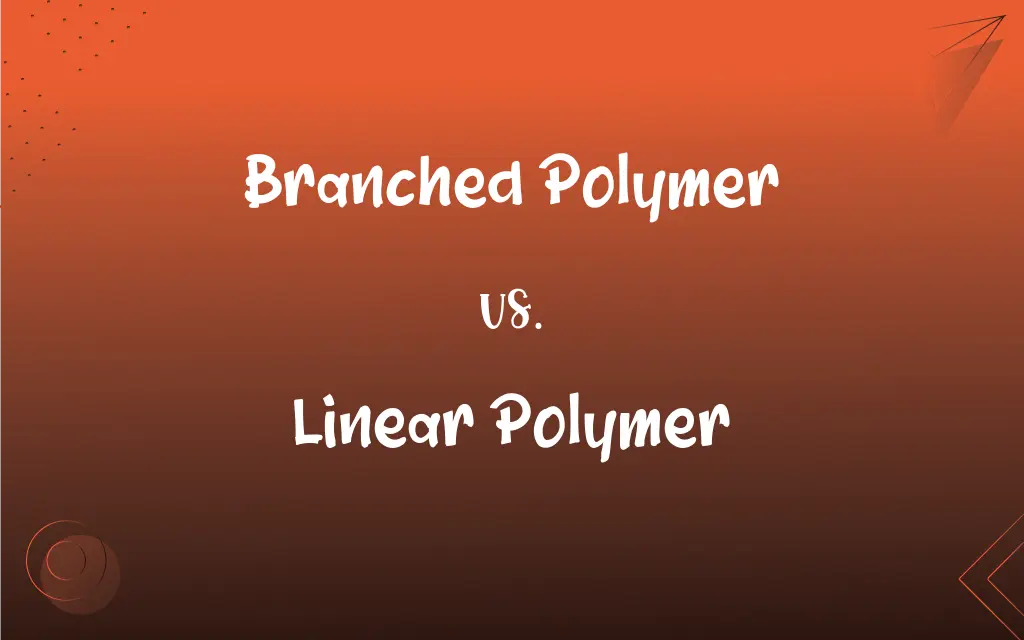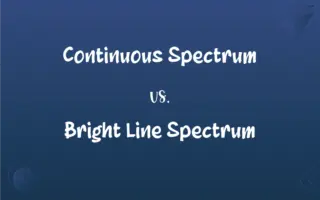Branched Polymer vs. Linear Polymer: What's the Difference?
Edited by Janet White || By Harlon Moss || Updated on November 22, 2023
Branched polymers have a structure with side-chain branches off the main chain, while linear polymers consist of long, continuous, unbranched chains.

Key Differences
Branched polymers are characterized by their molecular structure that includes one or more side chains branching off the main chain. Linear polymers, in contrast, consist of monomers joined end-to-end in single, unbranched chains.
The presence of branches in branched polymers affects their physical properties, such as decreasing density and increasing solubility. Linear polymers, being unbranched, typically have higher density and may be less soluble.
In branched polymers, the branches can interfere with close packing of chains, leading to lower crystallinity. Linear polymers can pack more closely, often resulting in higher crystallinity and strength.
Branched polymers tend to have a more amorphous structure and can be more flexible. Linear polymers, with their orderly structure, usually exhibit greater rigidity and higher melting points.
The synthesis of branched polymers often involves specific conditions or catalysts to encourage branching. The production of linear polymers is typically more straightforward, involving fewer variables in the polymerization process.
ADVERTISEMENT
Comparison Chart
Structure
Has side-chain branches off the main chain
Consists of long, continuous, unbranched chains
Physical Properties
Generally lower density, more soluble
Higher density, may be less soluble
Crystallinity
Lower due to interference of branches
Higher due to closer packing of chains
Flexibility/Rigidity
More flexible due to amorphous structure
More rigid due to orderly structure
Synthesis Complexity
Often requires specific conditions for branching
Simpler process, typically straightforward polymerization
ADVERTISEMENT
Branched Polymer and Linear Polymer Definitions
Branched Polymer
A polymer with a non-linear, branched molecular architecture.
The branched structure of starch makes it useful in food and industrial applications.
Linear Polymer
A polymer with monomers joined in a continuous, linear sequence.
Linear polymers like PVC are used in construction for their rigidity and durability.
Branched Polymer
Polymers having branches that stem from the main backbone.
In branched polymers like gum arabic, branching affects solubility and viscosity.
Linear Polymer
Polymers characterized by long, unbranched chains.
High-density polyethylene (HDPE), a linear polymer, is used for making strong plastic containers.
Branched Polymer
Polymers where the molecular structure is not just a straight chain.
Branched polymers are used in adhesives due to their flexible molecular structure.
Linear Polymer
A polymer consisting of a straight, unbranched chain of monomers.
Polyethylene terephthalate (PET), a linear polymer, is widely used in making bottles.
Branched Polymer
A polymer with side chains branching off the main chain.
Low-density polyethylene (LDPE) is a common branched polymer used in plastic bags.
Linear Polymer
A type of polymer with a straight chain molecular structure.
Linear polymers are preferred in certain electronics due to their high crystallinity and stability.
Branched Polymer
A type of polymer where side chains are attached to the main chain.
Branched polymers are often used in paints for improved application properties.
Linear Polymer
Polymers where monomers are linked end-to-end in a single chain.
Nylon, a linear polymer, is known for its strength and is used in textiles.
FAQs
Are linear polymers stronger than branched ones?
Generally, they have higher strength due to closer packing.
How does branching affect a polymer’s properties?
It often leads to lower density and increased flexibility.
What are the melting points like for linear polymers?
They tend to have higher melting points.
What defines a linear polymer?
A polymer consisting of long, continuous, unbranched chains.
What is a branched polymer?
A polymer with side chains branching off the main chain.
Are branched polymers used in adhesives?
Yes, their flexibility makes them suitable for adhesives.
Is the production of linear polymers complex?
It is typically less complex than branched polymer synthesis.
Can branched polymers be crystalline?
Yes, but they usually have lower crystallinity than linear ones.
What are common uses of linear polymers?
Packaging, textiles, construction materials.
Can branching be controlled in polymer synthesis?
Yes, through specific conditions and catalysts.
Do linear polymers have high or low density?
Generally, they have a higher density.
Do branched polymers have good solubility?
Often, they are more soluble than linear polymers.
Can linear polymers be recycled?
Many, like PET, are recyclable.
Is LDPE a branched or linear polymer?
LDPE is a branched polymer.
Can linear polymers be flexible?
They are usually less flexible than branched polymers.
Is branching important in polymer chemistry?
Yes, it significantly influences polymer properties and applications.
Why are linear polymers used in bottles?
For their strength and chemical stability.
Are branched polymers used in food applications?
Yes, like starch in food processing.
Are all plastics made of linear polymers?
No, many plastics use branched polymers as well.
What is the impact of polymer branching on viscosity?
Branching can increase a polymer's viscosity.
About Author
Written by
Harlon MossHarlon is a seasoned quality moderator and accomplished content writer for Difference Wiki. An alumnus of the prestigious University of California, he earned his degree in Computer Science. Leveraging his academic background, Harlon brings a meticulous and informed perspective to his work, ensuring content accuracy and excellence.
Edited by
Janet WhiteJanet White has been an esteemed writer and blogger for Difference Wiki. Holding a Master's degree in Science and Medical Journalism from the prestigious Boston University, she has consistently demonstrated her expertise and passion for her field. When she's not immersed in her work, Janet relishes her time exercising, delving into a good book, and cherishing moments with friends and family.








































































